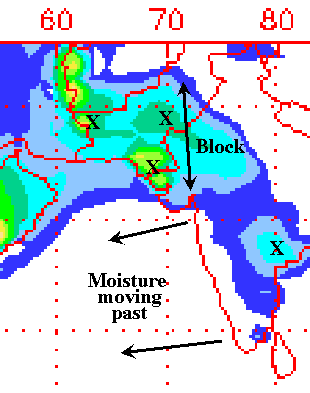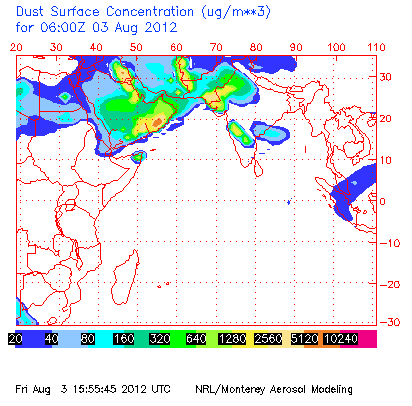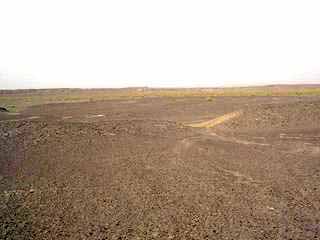Super Cyclone GONU trapped by the Dust Cloud in the Straits of Hormuz in 2007.
As posted on July 26, 2012
on the Pakistan Weather Portal:
PAKISTAN balanced on edge of floods and drought, due to atmospheric dust
Large parts of Pakistan are dry
The rainfall image above [from the Pakistan Weather Portal] is a very bad image to see, and shows the power of the atmospheric dust over Pakistan. The dust backs up the moisture and causes flooding and drought more efficiently than if you has a mountain range stopping that moisture.
For example, the USA is experiencing the worst drought in 50 years, because the dust cloud hovering over Arabia is blocking the westward flow of monsoonal moisture from India to the USA.
Today, you can see upstream of Pakistan where the monsoon originates north of Australia, at https://www.ssec.wisc.edu/data/comp/latest_cmoll.gif, a huge amount of clouds are gathering to move westward. The position of the atmospheric dust over Pakistan and Arabia will dictate if Pakistan and the Arabian peninsula will be in drought conditions in the next 30 days, or experience massive floods.
Do not expect normal conditions for the monsoons in Pakistan from this year forward, until the atmospheric dust cloud over Pakistan is recognized and managed. The dust cloud is the most powerful controlling factor for rainfall on the planet, and since it is man-made, we have the ability to manage it.
Or we will be at the mercy of the Dust Cloud
when it causes abnormal swings in the normal monsoon rainfall
extremes, of severe drought like the USA is experiencing, or massive
floods. It is up to Pakistan and the countries of the
Arabian peninsula to start managing this dust cloud, so that all
of the peoples west of India can get consistent and normal rainfall
each year.
We can start by the having our governments
and meteorologists acknowledging that the Dust Cloud exists, then
form a plan to manage the conditions on the ground that create
the dust cloud, so that it does not play a role in causing
droughts or floods in the future. Reference: https://www.ecoseeds.com/cool.html..
7-27-2012 atmospheric Dust Cloud
7-27-2012 IR satellite
I have attached July 27, IR satellite plus the NAAPS dust image, and you can see the wall that the dust makes to stop the westward movement of the monsoonal moisture. One the other hand, you see where in northern Pakistan, the Dust Cloud is absent, which means that there is a potential for the moisture to move in that direction and cause flooding.
The dust also shows the critical areas that need the first attentions for natural revegetation using the local native plants, to cover the soil and keep the dust from getting airborne in the first place.
I am hoping that Pakistan and the Arabian
countries, could have a joint meeting to discuss this issue sometime
in the near future, because the agriculture in both Pakistan and
the USA depend on recognizing the problem, then start to do something
to stop the dust from becoming airborne in the first place, like
revegetation with the local native perennial
grasses.
7-28-2012 IR clouds

7-28-2012 atmospheric Dust Cloud
Today the monsoon-dust battle at the India/Pakistan border
I have attached the monsoon-dust battle images of July 28 from the India/Pakistan border, with X on the spots where the dust is originating that is causing the problems.
8-1-2012 IR clouds
8-1-2012 atmospheric Dust Cloud
I have attached today's Dust Cloud and cloud images, and you can see the blocking edge of the Dust Cloud roughly at the Pakistan-India border. All of the other monsoon influences are insignificant compared to the Dust Cloud, and needs to be monitored and start to be corrected on the ground.
When the Dust Cloud is thick, there is drought in Pakistan and floods in India by its blocking effect. Then, if the cloud goes away over Pakistan like in 2010, then the floods come, because there is nothing between India and Pakistan to block that rainfall, except for the Dust Cloud.
You can see the day-by-day effects of the
Dust Cloud in 2010 at
https://www.ecoseeds.com/floods.html.
I am hoping that sometime this year, a meeting could be organized in Pakistan at least, to invite meteorologists, government officials and ecologists to start a discussion about the Dust Cloud.
It might be a good meeting to also invite representatives from India, because their western man-made deserts along the SE border of Pakistan is a source of the Dust Cloud.
Establishment of Ecological Restoration preserves, as I am suggesting for the Arabian peninsula at https://www.ecoseeds.com/cool.html, the currently barren lands where the Dust Clouds are originating, need to be established as preserves.
Instead of grazing that land to dust, which
then gets blown into the air as the Dust Cloud, those people need
to be paid to replant the local native vegetation, to keep the
soil from getting airborne in the first place. That could be accomplished
by selling Carbon Credits to Europe for the carbon that those
replanted native plants will sequester in the soil, for each hectare
replanted.
8-3-2012 IR clouds

8-3-2012 atmospheric Dust Cloud
August 4, 2012 Dust and IR clouds
The atmospheric dust cloud is successfully keeping the monsoon away from Pakistan, and the mini-Dust Cloud in India, is acting like a rock in a stream, and forcing the monsoon moisture to split as the monsoon moves westward.
The paradox of the Dust Cloud, is where grazing has removed vegetation, that is the home of the Dust Cloud, which then creates more severe drought conditions, and starts a feed-back cycle, to create more severe drought, as more dust gets airborne, etc.
When grazing the home of the Dust Cloud, leaving a few centimeters of standing vegetation to remain, instead of grazing to bare ground, would begin to cure the Dust Cloud.
One permanent cure, would be to revegetate the Dust Cloud homelands with the original native perennial grasses and local native trees, and to pay the local people to protect those areas as Ecological Restoration preserves, instead of using the Dust Cloud lands for animal fodder.
Fixing the Dust Cloud homeland vegetation cover is essential for the peoples of western India, Pakistan and the United States, because we all depend on the monsoonal moisture to grow our crops each year.
August 8, 2012 dust, IR clouds and 24 hour rainfall.
Dense clouds at the Pakistan/India border trying to move westward to provide rain for the people of Pakistan, but the Dust Cloud is holding firm. However, the rain clouds can go around the Dust Cloud, by going to the north, as you can see from the HAMweather.net rainfall map.
August 10, 2012 - Pakistan-Arabian dust stops rain to both Americas.
I was noticing today, as well as the Dust
Clouds in Pakistan and Arabia causing drought in Pakistan and
the USA, it is also causing the worst drought in 100 years in
the Amazon, if you Google <drought Amazon August 2012>.
You can see this impact by watching https://www.ssec.wisc.edu/data/comp/latest_cmoll.gif.
Only central America is getting rainfall this summer so far.
August 13, 2012 - DUST CLOUD could kill a million children in the Sahel.
The Pakistan and Arabia atmospheric Dust
Cloud, this week, while blocking the India monsoon moisture, and
causing the worst droughts in decades in North and South America,
is also producing drought in the Sahel of Africa, and one million
children may die. See Google <August 2012 drought Sahel>.
It is truly amazing how the land management of two key places
on the planet, Pakistan and Arabia, can impact on so many hundreds
of million of people on three continents. If our domesticated
animals are allowed to eat the wild grasses too short in Pakistan
and Arabia, then millions can die in Africa.
Perhaps an annual payment could be paid
by the rest of the world, to pay the people currently grazing
those areas, to preserve and replant those key grassland areas
as Ecological Restoration Preserves instead, so that millions
will not have to starve? Attached is the image from today showing
the Dust Cloud blocking the monsoon and only thin to no rain clouds
over the Sahel, where the starving children live.
August 18, 2012, FIXING THE SOURCE-LOCATIONS of the Dust Cloud.
India and Pakistan are homes of the atmospheric Dust Cloud, and you can see pictures on-the-ground at https://www.ecoseeds.com/africa_india_megatransect.html.
Confluence.org on-the-ground photos are used with permission.
Here are three pictures of the Dust Cloud
home:
India, 5.1 km (3.2 miles) NE of Pimpalgaon, Andhra Pradesh, 19N
78E.

India, 3.8 km (2.4 miles) ESE of Fatehpur, Rajasthan, 28N 75E.

Pakistan, 8.9 km (5.5 miles) SSW of Ware
Sahib Chah, Balochistan, 29N 62E. (Sand
storm was blowing when this picture was taken August 15, 2006).
Since the atmospheric Dust Cloud is more powerful than a Super
Category-5 cyclone like Gonu in 2007, the only way to solve this
man-made problem is to patch up the barren earth with local native
perennial vegetation, and no bare soil is exposed to get airborne
each summer and interfere with the monsoonal moisture.
This atmospheric Dust Cloud is a perfect example of the Mathematical Chaos theory model of the "Butterfly Effect", where a seemingly insignificant change, like some cattle or sheep eating some wildland grasses and creating bare soil conditions in Pakistan or India, can cause a drought in North Africa in the Sahel, or in North America and the Amazon basin.
Here are two proposals for the revegetation of the Dust Cloud source-locations in India and Pakistan.
A strip of local native annual grasses, wildflowers, perennial
grasses and native trees are replanted in a north-south line,
and eventually covering all of the bare soil areas, working towards
to Hyderabad. This should bring the whole area up to at least
80 cm of annual rainfall on a regular basis.
The Pakistan-Western India source of the Dust Cloud, could be fixed by replanting a strip of local native annual grasses, wildflowers, perennial native grasses and native trees, in a line from Lahore, Pakistan to Delhi, India, and eventually covering all of the bare soil areas southwestward to the Arabian Sea. This cover of vegetation will kill the Dust Cloud formation in that area and could help bring 80 cm of annual rainfall on a consistent basis each year. It would also break the Dust Cloud wall and pockets, that causes the monsoon to stall and produces floods, like in Pakistan in 2010
August 20, 2012 - HOW TO FIX the Dust Cloud, one step is to complete the Confluence.org photos of your country.
There are basic steps each country could take to fix the Dust Cloud.
One of the most interesting beginning steps would be to complete any missing Confluence.org latitude and longitude photos. Those photos provide a country-wide look at the scale of the problem, and also act as beginning baseline reference photos that can be referred to, as you begin to revegetate the Dust Cloud source areas.
For example, most of the Confluence.org
photos have been completed for the Kingdom of Saudi Arabia, and
the Sultanate of Oman. You can see them, with an Ecological Restoration
rating for each area, at Saudi_mega.html,
Saudi_northmega.html
and oman_megatransect.html.
Completing the Confluence.org photos would be relatively easy to do--all you need is a vehicle, a GPS reader, and a camera. You can drive to each point that is missing for your country, photograph it and submit it to the Confluence.org project for posting on their web site.
Using the Confluence.org photos, an Ecological Restoration rating scale could be developed, like:
0 = No native vegetation is visible, and no soil with organic
matter seen.
1= Zero plant cover, but organic matter still appears to be in
the soil. This indicates that vegetation was present in the area
in the last 50-200 years, so ecological restoration would be more
likely to succeed in these areas with nutrients and organic matter
still present.
2 = Plant cover present, should be preserved as an ecological
restoration site.
Confluence.org photo from Oman at 24N 57E, with an Ecological
Restoration rating of 2.
Two powerful words that could be our best tool--Ecological Restoration.
Using the science and technologies that these two words represent, as a tool to fix the Dust Cloud, can save the lives of hundreds of millions of people who depend on the annual monsoon rains in summer. The people of Pakistan, western India, the Arabian peninsula, and the Sahel of Africa, the farmers of North America, and the Amazon basin forests are all dependent on the same regular rainfall each year. Many lives depend on us learning to use Ecological Restoration as a tool, to manage the Dust Cloud's effects of the summer monsoon rainfall patterns.
The Dust Cloud is a man-made obstacle to the summer monsoon moisture, so by using our knowledge of the Dust Cloud plus Ecological Restoration, we should be able to fix it.
August 21, 2012 - The Dust Cloud image from today, shows that there is a possibility of part of the monsoon to move north of the Dust Cloud, to produce rain wherever the Dust Cloud is not covering Pakistan in the north. However, if you look upstream where the monsoon originates, north of Australia, there is a lot of moisture being generated, and wherever there is an opening in the Dust Cloud also can produce the potential for floods in the next 10 days or so.
The Dust Cloud is like a double-edged sword, and the other side is that whatever parts of Pakistan and western India that the Dust Cloud covers each day, is nearly guaranteed to continue with drought.
August 22, 2012 - The monitoring of the
Dust Cloud gave a 24 hour notice before Pakistan was hit by floods.
Google <Pakistan floods August 2012> and you read: "Muzaffarabad,
Pakistan, Aug 23, 2012 (AFP) - Flash floods and landslides
triggered by heavy rain have killed at least 26 people..."
or "A Pakistani girl sits in her house flooded by heavy rains
in Nowshera, near Peshawar, Pakistan on Wednesday, Aug. 22, 2012."
Daily Dust Cloud monitoring, could give
officials at least a 24 hour warning of future flooding in Pakistan.
August 29, 2012 - India and the USA today
from satellite, and colors digitally enhanced. The drought in
India looks much more severe than has been reported so far. India
may be entering into a cycle this year, of drought creating barren
land, which then keeps rainfall from falling in those areas, which
makes the drought more severe.
September 2012 + discussions continued
here.
Updated December 20, 2022 - Go to The Reveg Edge website